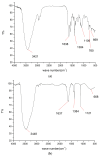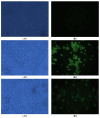Synthesis and Characterization of Sulfonamide-Containing Naphthalimides as Fluorescent Probes
- PMID: 38930839
- PMCID: PMC11206436
- DOI: 10.3390/molecules29122774
Synthesis and Characterization of Sulfonamide-Containing Naphthalimides as Fluorescent Probes
Abstract
A tumor-targeting fluorescent probe has attracted increasing interest in fluorescent imaging for the noninvasive detection of cancers in recent years. Sulfonamide-containing naphthalimide derivatives (SN-2NI, SD-NI) were synthesized by the incorporation of N-butyl-4-ethyldiamino-1,8-naphthalene imide (NI) into sulfonamide (SN) and sulfadiazine (SD) as the tumor-targeting groups, respectively. These derivatives were further characterized by mass spectrometry (MS), nuclear magnetic resonance spectroscopy (1H NMR), Fourier transform infrared spectroscopy (FT-IR), ultraviolet-visible spectroscopy (UV), and a fluorescence assay. In vitro properties, including cell cytotoxicity and the cell uptake of tumor cells, were also evaluated. Sulfonamide-containing naphthalimide derivatives possessed low cell cytotoxicity to B16F10 melanoma cells. Moreover, SN-2NI and SD-NI can be taken up highly by B16F10 cells and then achieve good green fluorescent images in B16F10 cells. Therefore, sulfonamide-containing naphthalimide derivatives can be considered to be the potential probes used to target fluorescent imaging in tumors.
Keywords: fluorescent imaging; fluorescent probe; naphthalimide; sulfadiazine; sulfonamide.
Conflict of interest statement
The authors declare no conflicts of interest.
Figures










References
-
- Tao L., Liu S., Xia X., Chai Y., Cai S., Liu H., Lu C., Ma C., Nie J., Zeng F., et al. Near-infrared fluorescent read-out probe for ultra-sensitive imaging of leucine aminopeptidase in vitro and in vivo. Tetrahedron. 2021;99:132449. doi: 10.1016/j.tet.2021.132449. - DOI
-
- Zhang Y.B., Sun L., Yan Q., Qiu X.Y., Cheng Y.T., Wang B.L., Tan X.P., Fang M.X., Luck R.L., Liu H.Y. Near-infrared fluorescent probe based on cyanine scaffold for sensitive detection of uranyl ions in living cells and water samples. Microchem. J. 2022;180:107619. doi: 10.1016/j.microc.2022.107619. - DOI
MeSH terms
Substances
Grants and funding
LinkOut - more resources
Full Text Sources

